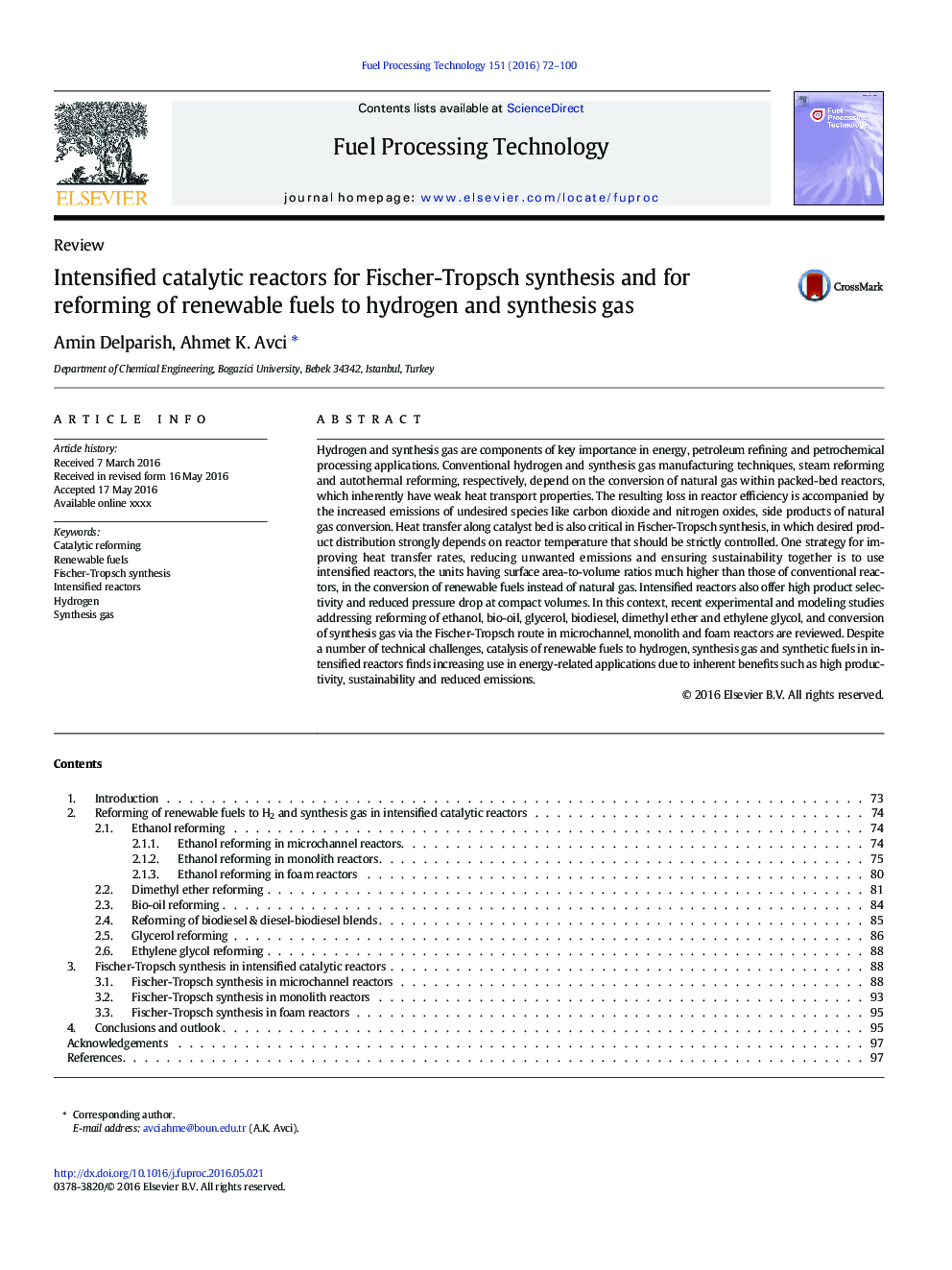| کد مقاله | کد نشریه | سال انتشار | مقاله انگلیسی | نسخه تمام متن |
|---|---|---|---|---|
| 6656596 | 461654 | 2016 | 29 صفحه PDF | دانلود رایگان |
عنوان انگلیسی مقاله ISI
Intensified catalytic reactors for Fischer-Tropsch synthesis and for reforming of renewable fuels to hydrogen and synthesis gas
ترجمه فارسی عنوان
راکتورهای کاتالیزوری شدید برای سنتز فیشر-تروپش و اصلاح سوخت های تجدید پذیر به هیدروژن و گاز سنتز
دانلود مقاله + سفارش ترجمه
دانلود مقاله ISI انگلیسی
رایگان برای ایرانیان
کلمات کلیدی
اصلاح کاتالیستی، سوخت های تجدید پذیر، سنتز فیشر-تروپش، راکتورهای شدید هیدروژن، گاز سنتز،
ترجمه چکیده
گاز هیدروژن و سنتز جزء اهمیت کلیدی در برنامه های پردازش انرژی، فرآوری نفت و پتروشیمی است. به طور عمده تکنیک های تولید هیدروژن و سنتز گاز، اصلاح بخار و رفع خستگی اتوترمال به ترتیب به تبدیل گاز طبیعی در داخل راکتورهای بسته بندی بستگی دارد که به طور ذاتی ویژگی های انتقال حرارت ضعیفی دارند. از دست دادن در راندمان کارکرد رآکتور با افزایش انتشار گازهای ناخواسته مثل دی اکسید کربن و اکسید نیتروژن همراه است، تولیدات جانبی تبدیل گاز طبیعی همراه است. انتقال حرارت در بستر کاتالیزور نیز در سنتز فیشر-تروپچ مهم است، در حالیکه توزیع محصول مورد نظر به شدت به دمای رآکتور بستگی دارد که باید به شدت کنترل شود. یک استراتژی برای بهبود نرخ انتقال حرارت، کاهش انتشار ناخواسته و اطمینان از پایداری با هم، استفاده از راکتورهای تشدید شده است، واحدهای نسبت مساحت سطح به حجم خیلی بالاتر از رآکتورهای معمولی، در تبدیل سوخت های تجدیدپذیر به جای گاز طبیعی. راکتورهای به کار رفته در این محصول همچنین انتخاب انتخابی بالا و کاهش فشار در حجم کم را ارائه می دهند. در این راستا، مطالعات تجربی و مدلسازی اخیر در مورد اصلاح اتانول، بیولوژیکی، گلیسرول، بیودیزل، دی متیل اتر و اتیلن گلیکول و تبدیل گاز سنتز از طریق مسیر فیشر تروپچ در میکرو کانال، یکپارچه و فوم مورد بررسی قرار گرفته است. با وجود تعدادی از چالش های فنی، کاتالیز سوخت های تجدید پذیر به هیدروژن، گاز سنتز و سوخت های مصنوعی در راکتورهای شدید، به دلیل مزایای ذاتی مانند بهره وری بالا، پایداری و کاهش انتشار، در استفاده از برنامه های مرتبط با انرژی افزایش می یابد.
موضوعات مرتبط
مهندسی و علوم پایه
مهندسی شیمی
مهندسی شیمی (عمومی)
چکیده انگلیسی
Hydrogen and synthesis gas are components of key importance in energy, petroleum refining and petrochemical processing applications. Conventional hydrogen and synthesis gas manufacturing techniques, steam reforming and autothermal reforming, respectively, depend on the conversion of natural gas within packed-bed reactors, which inherently have weak heat transport properties. The resulting loss in reactor efficiency is accompanied by the increased emissions of undesired species like carbon dioxide and nitrogen oxides, side products of natural gas conversion. Heat transfer along catalyst bed is also critical in Fischer-Tropsch synthesis, in which desired product distribution strongly depends on reactor temperature that should be strictly controlled. One strategy for improving heat transfer rates, reducing unwanted emissions and ensuring sustainability together is to use intensified reactors, the units having surface area-to-volume ratios much higher than those of conventional reactors, in the conversion of renewable fuels instead of natural gas. Intensified reactors also offer high product selectivity and reduced pressure drop at compact volumes. In this context, recent experimental and modeling studies addressing reforming of ethanol, bio-oil, glycerol, biodiesel, dimethyl ether and ethylene glycol, and conversion of synthesis gas via the Fischer-Tropsch route in microchannel, monolith and foam reactors are reviewed. Despite a number of technical challenges, catalysis of renewable fuels to hydrogen, synthesis gas and synthetic fuels in intensified reactors finds increasing use in energy-related applications due to inherent benefits such as high productivity, sustainability and reduced emissions.
ناشر
Database: Elsevier - ScienceDirect (ساینس دایرکت)
Journal: Fuel Processing Technology - Volume 151, October 2016, Pages 72-100
Journal: Fuel Processing Technology - Volume 151, October 2016, Pages 72-100
نویسندگان
Amin Delparish, Ahmet K. Avci,
